
A pancake is a flat cake, often thin and round, prepared from a starch-based batter that may contain eggs, milk and butter and cooked on a hot surface such as a griddle or frying pan, often frying with oil or butter. Archaeological evidence suggests that pancakes were probably the earliest and most widespread cereal food eaten in prehistoric societies.

A baker is someone who bakes and sometimes sells breads and other products made of flour by using an oven or other concentrated heat source. The place where a baker works is called a bakery.

A crêpe or crepe is a type of very thin pancake. Crêpes are usually of two types: sweet crêpes and savoury galettes. Crêpes are served with a variety of fillings, from the simplest with only sugar to flambéed crêpes Suzette or elaborate savoury galettes. While crêpes are often associated with Brittany, a region in the northwest of France, their consumption is widespread in France, Belgium, Canada, and many parts of Europe, North Africa, Lebanon, and the Southern Cone of South America.

Hújiāo bǐng or Pepper bun is a type of baked bun that originated in city of Fuzhou, the capital of China's Fujian province. It is a street food that has become quite popular in Taiwan and can be found in night markets or mini food stalls throughout Taiwan. The common ingredients are flour, water, and a leavening agent for the outer dough shell, and a meat protein marinated with sugar, soy sauce, white pepper or black pepper, and scallion for the inside filling.

Kuih are bite-sized snack or dessert foods originating from Southeast Asia. It is a fairly broad term which may include items that would be called cakes, cookies, dumplings, pudding, biscuits, or pastries in English and are usually made from rice or glutinous rice. The term kueh or kuih is widely used in Malaysia, Brunei, Singapore and Indonesia to refer to sweet or savoury desserts. Though called by other names, one is likely to find various similar versions of kuih in neighbouring countries, such as Vietnam, Thailand, and Myanmar. For example, the colourful steamed kue lapis and the rich kuih bingka ubi are also available in Myanmar, Thailand, and Vietnam.

Laobing is a type of unleavened flatbread popular in parts of northern China, including Beijing. It is sometimes referred to as a Chinese pancake.

A flatbread is a bread made with flour, water and salt, and then thoroughly rolled into flattened dough. Many flatbreads are unleavened—although some are slightly leavened, such as pita bread.

Puran poli is an Indian sweet flatbread.
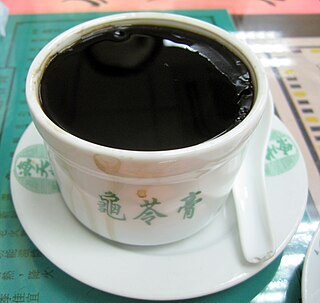
Guīlínggāo, also known as Tortoise Jelly or Turtle Jelly, is a jelly-like Chinese medicine, also sold as a dessert. It was traditionally made from the powdered plastron from the turtle Cuora trifasciata and a variety of herbal products, in particular, China roots Smilax glabra . Although the golden coin turtle is commercially farmed in modern China, it is extremely expensive; therefore, even when turtle-derived ingredients are used in commercially available guīlínggāo, they come from other, more commonly available, turtle species.
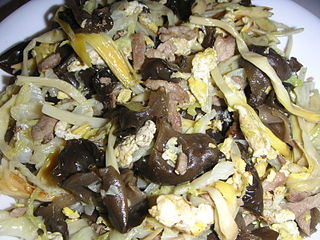
Moo shu pork is a dish of northern Chinese origin, possibly originating from Shandong. It is believed to have first appeared on the menus of Chinese restaurants in the United States in the late 1960s, and is also a staple of American Chinese cuisine.

Kue is an Indonesian bite-sized snack or dessert food. Kue is a fairly broad term in Indonesian to describe a wide variety of snacks; cakes, cookies, fritters, pies, scones, and patisserie. Kue are made from a variety of ingredients in various forms, some are steamed, fried or baked. Kue are popular snacks in Indonesia, which has the largest variety of kue. Because of the countries' historical colonial ties, Koeé (kue) is also popular in the Netherlands.

Bing is a wheat flour-based Chinese food with a flattened or disk-like shape, similar to the French concept of a galette. These foods may resemble the flatbreads, pancakes and unleavened dough foods of non-Chinese and western cuisines. Many of them are similar to the Indian roti, French crêpes, or Mexican tortilla, while others are more similar to Western cakes and cookies.
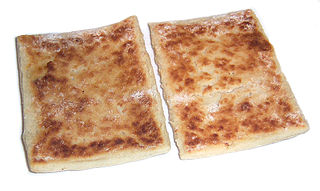
A potato cake is usually made from deep-fried potatoes that have been thinly sliced or mashed.
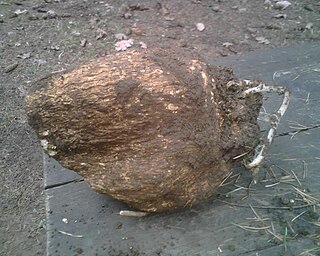
Wolfiporia extensa (Peck) Ginns is a fungus in the family Polyporaceae. It is a wood-decay fungus but has a subterranean growth habit. It is notable in the development of a large, long-lasting underground sclerotium that resembles a small coconut. This sclerotium called "(Chinese) Tuckahoe" or fu-ling(茯苓, pīnyīn: fúlíng), is not the same as the true tuckahoe used as Indian bread by Native Americans, which is the arrow arum, Peltandra virginica, a flowering tuberous plant in the arum family. W. extensa is also used extensively as a medicinal mushroom in Chinese medicine. Indications for use in the traditional Chinese medicine include promoting urination, to invigorate the spleen function, and to calm the mind.

Chinese desserts are sweet foods and dishes that are served with tea, along with meals or at the end of meals in Chinese cuisine. The desserts encompass a wide variety of ingredients commonly used in East Asian cuisines such as powdered or whole glutinous rice, sweet bean pastes, and agar. Due to the many Chinese cultures and the long history of China, there are a great variety of desserts of many forms.

Street food, as in other areas of India, are popular in Chennai, despite the common belief in India that street food is unhealthy. The Idly Sambhar is a popular dish, which is served as breakfast or dinner. Apart from regular South Indian street food, the city's streets are also filled with several North Indian street food outlets, most of them established by North Indian migrants themselves. Gujarati and Burmese are also available. Street food in Chennai is so popular that a game had developed based on the TV show The Amazing Race where contestants have to follow clues to Street-food spots in the city.
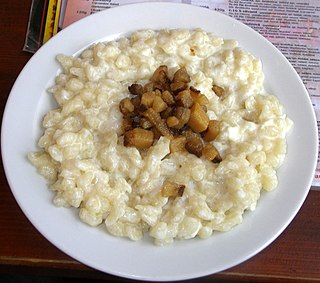
Traditional foods are foods and dishes that are passed through generations or which have been consumed many generations. Traditional foods and dishes are traditional in nature, and may have a historic precedent in a national dish, regional cuisine or local cuisine. Traditional foods and beverages may be produced as homemade, by restaurants and small manufacturers, and by large food processing plant facilities.

Roti Jala, literally meaning "Net Bread", is a popular Malay tea time snack served with curry dishes which can be found in Indonesia, Malaysia and Singapore. The roti jala is a pretty dish that looks like a lace doily due to the way it is made. This is a very traditional Malay dish that is usually homemade and served at events such as weddings and festivals. It is usually eaten in sets of three to four pieces with curries, especially chicken curry, as a substitute to rice.

Spring rolls are a large variety of filled, rolled appetizers or dim sum found in East Asian, South Asian, and Southeast Asian cuisine. The name is a literal translation of the Chinese chūn juǎn. The kind of wrapper, fillings, and cooking technique used, as well as the name, vary considerably within this large area, depending on the region's culture.
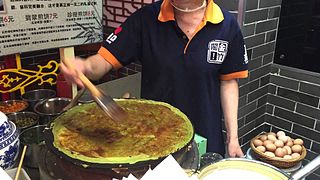
Jianbing is a traditional Chinese street food similar to crepes. It is a type of bing generally eaten for breakfast and hailed as "one of China's most popular street breakfasts." The main ingredients of jianbing are a batter of wheat and grain flour, eggs and sauces. It can be topped with different fillings and sauces such as baocui, ham, chopped or diced mustard pickles, scallions and coriander, chili sauce or hoisin sauce depending on personal preference. It is often folded several times before serving.






















